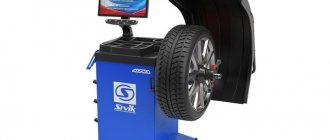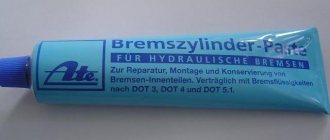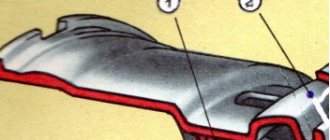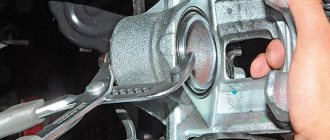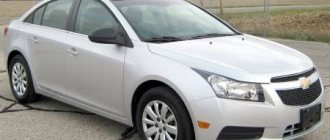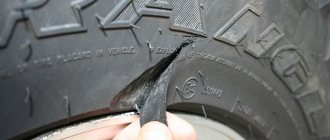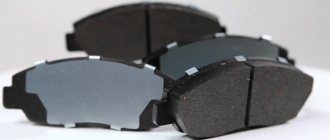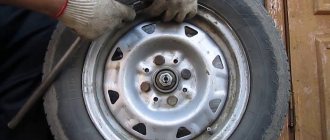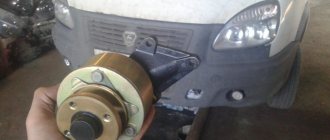Here you can get a discount on tires in Voronezh.
Monitoring the condition of your car is the responsibility of the owner or driver. Interaxle rearrangement of wheels is one of the types of maintenance. The rule of tire castling is not new and has been used by drivers for many decades. Moreover, the procedure is equally useful for cars and trucks.
In addition to maintaining the technical characteristics of the car's handling, owners are able to delay the purchase of new wheels. And thriftiness of the personal budget is encouraged by family members. Unfortunately, the commandment of castling tires is being forgotten. It is remembered at the moment of significant wear and tear.
Is it worth changing tires?
The opinions of motorists on the issue of changing wheels on a car differ in some places.
The first group claims that the procedure is useless and harms the tires. The second category constantly uses the procedure in the belief that this allows for maximum uniform tire wear. Both statements are true in their own way, but in individual cases. Tires on passenger cars need to be changed constantly. The requirement is due to the uneven load on different wheels and, as a result, different wear. The requirement is especially relevant for trucks. Here, when changing the shoes of the car and trailer, it is necessary to change the tires. The load of a tractor and a truck is very different.
The procedure is limited to vehicles equipped with a pressure control system. The control unit determines what side it is on, and if there is a puncture, it shows the driver the location of the puncture. If you mix up the disks, errors in the on-board system may occur.
Tire transfer is done according to a certain pattern. If you install your wheels incorrectly, the desired effect will not be achieved.
Why is this necessary?
Car tire wear is uneven. Let's start with the fact that the front wheels deteriorate faster than those placed on the rear. After all, the front of your car accounts for about 60% of the total weight. The wear of tires placed in front is also affected by turns. When driving on the right side of the road, we turn much more to the left than to the right.
Also interesting: The most inexpensive used passenger all-wheel drive cars
Consequently, the right front tire is subject to wear more than others. Rotating the wheels will help solve the issue of uneven tire wear. This will provide you with significant cost savings on car maintenance and predictable steering effort. And, like a real man, you can change the tires on your car yourself.
How to properly swap wheels on a car
It is necessary to correctly change the positions of the slopes according to a certain pattern. The sequence of actions is different for each drive type. There are standards common to all cars:
- all elements are rearranged at the same time;
- the procedure is performed after driving 8-9 thousand kilometers;
- the directional protector must not be rearranged crosswise;
- Non-directional tires are rotated diagonally.
Scheme
The figure shows the sequence of actions for different drives and tire types.
- Front.
- Rear.
- Full.
- Rearrangement method in the presence of an asymmetric tread. Does not depend on the design of the vehicle's chassis.
According to the scheme, the replacement is performed in this way.
- the rear wheels are moved in a cross to the front;
- the front axle is shifted parallel to the rear.
For rear-wheel drive, changing tires is carried out in a mirror manner to the instructions, which indicate the nose drive axle. In the case of 4x4 vehicles, all ramps are rearranged diagonally.
If tires with an asymmetric tread are used, the rearrangement is carried out exclusively in parallel. Front to back and vice versa.
How to change tires according to the season
Seasonal tire replacement is performed every year. If it is necessary to swap winter tires for summer ones, all actions are performed according to the above scheme. In order to change wheels correctly, experienced car enthusiasts recommend making marks on the tires before storing them, indicating the previous location of the slopes.
Which tires are better
Based on the cord design, radial tires are preferable. Such tires are more reliable, they can withstand heavy loads when driving, and are more stable when deformed. Radial tires take longer to wear than bias-ply tires. Therefore, bias-ply tires are practically not produced at present.
All-season tires can be used in both summer and winter. Winter tires can be studded. Such tires are allowed only in a few countries where snow often and heavily falls in winter and ice forms on the road surface. Russia is also on this list. All-season, summer and winter tires have their own design characteristics that improve vehicle handling.
Front-wheel drive or rear-wheel drive vehicles can be equipped with tires with different patterns. Such tires are installed in pairs on one axle, for example, in front of the tire with one pattern, in the rear - with another. It is prohibited to install bias tires on one axle and radial tires on the other. The dimensions must be the same. All-wheel drive vehicles must have the same tires.
Also interesting: How to identify Niva problems by hearing and smell
Tires with different treads and different sizes are strictly prohibited. This is due to the design of the transmission. If you drive a car with different tires, the car's transmission will quickly fail. In addition, driving on different tires becomes dangerous; a car will behave unpredictably on a slippery road.
How to properly change winter tires
Winter modifications do not have any special requirements for the replacement sequence. Thus, the symmetrical studded or Velcro version must be rearranged according to the standard pattern, respecting the direction of the tread.
Some buyers ask whether studded tires can be rearranged. The answer is that metal inserts do not affect the wear of the rubber itself.
Reviews
Motorists' opinions on the procedure.
I rotate tires twice a season. I started after I noticed that the outer side of the tread on the rear axle was eating a little. Now wear is more even and the rubber lasts longer.
I rotate the wheels on the truck every month. If you don’t do this, the rear axle wears out the tires much faster and you have to constantly buy two more tires before the replacement date.
Source: rus-avtomir.ru
Rearranging wheels on a car: diagram, recommendations
What car are you the owner of? — Front-wheel drive, rear-wheel drive or all-wheel drive. Do you understand the mechanisms of a car, do you understand how its power and maneuverability on the road are justified, especially during descents and ascents? Often, the operation of cars takes place on a whim, only a part of the owners with their vehicle are on a first-name basis. An experienced and attentive driver clearly understands which part needs to be replaced as planned, whether it is necessary to rearrange the wheels, and what diagram is suitable for this. Not everyone, for example, can afford to allocate up to 20-30,000 rubles from the family budget twice a year to purchase a set of winter and summer tires. In order to save money, car owners are looking for acceptable solutions to the situation. And there may be several of them.
- “Once - yes much.” Some motorists think so and decide that it is better to buy expensive tires from a well-known brand, then you can count on quality, service, prestige and wear resistance of the product. Definitely the right decision. Firstly, premium tires are manufactured using innovative technologies, all high-level indicators are thought through, a quality stamp is given, and service life is extended. Secondly, expensive tires are a big responsibility. Of course, you can hope for their quality, and whether you can predict the road situation, whether you are able to find the ideal roadway without potholes or foreign sharp objects. There are no 100% safe roads, and any tire, be it economy class or premium, still does not last forever and is not insured against force majeure.
- “The sum does not change by changing the places of the terms.” A familiar rule from childhood. Among car owners, it is also used, only it is designated with a technical slant and sounds like this: rearranging the wheels on a car, the standard scheme is used.
- “A shirt worn to holes – still warm.” It’s practically a rag, but it’s a shame to throw it away. It may be a pity to part with your favorite clothes, but it is necessary if they no longer warm or decorate. But, of course, you can’t drive on bald tires! Unfortunately, in our society there are many reckless drivers who do not pay attention to the condition of the tires, they are not interested in rearranging the tires according to the scheme, they simply want to get to the goal in their car and are still happy that the car starts up every morning and does not refuse to carry passengers. And the fact that the braking distance has already exceeded all maximum indicators, that the car can sometimes drive, go into an uncontrolled skid - it doesn’t matter.
Automobile
There may be several ways out of the situation, but let’s pay attention to the simplest and most popular one - rearranging the wheels; the process diagram has never been complicated, and even more so, several variations are attributed to it. Choose practically without restrictions!
Tips for extending tire life
Monitor tire pressure
When climate conditions change and a number of other factors influence, tire pressure also changes. Driving on overinflated or flat tires leads to rapid wear of the tread, and low-pressure tires also significantly increase the braking distance and lead to damage to the metal frame. That is why it is recommended to check the tire pressure every 2 weeks and inflate them if necessary. You can find the optimal values for your car in the technical documentation.
Please note that when transporting heavy loads or a large number of passengers, the tire pressure must be increased.
Perform wheel alignment regularly
Incorrectly adjusted suspension settings lead to uneven wear of the tire tread, significantly reduce its service life and increase the risk of accidents while driving. The wheel alignment should be checked after each tire change, i.e. at least twice a year.
Rotate tires
In cars with front-wheel drive, the rear wheels work less intensively and therefore wear out much more slowly. In order for the wheel treads to wear evenly, it should be done every 8-10 thousand km. swap rear and front wheels. This will improve safety and provide the most comfortable driving experience.
Store correctly
The optimal conditions for storing tires are:
- a cool room protected from sunlight;
- average level of air humidity;
- distance from solvents, transformers and generators.
- The arrangement of tires is in a vertical position, the wheel assembly is in a horizontal position.
Before storing tires, you must also remove dirt and stones from them.
Drive calmly
Aggressive driving - frequent changes in direction, sharp braking and drifting - negatively affect the quality of tires, leading to wear of their tread in a short time. Measured driving will allow you to better control your car and significantly extend the life of your wheels.
Keep it clean
Regular washing is required not only for the car body, but also for its wheels.
It is recommended to clean them at least 2 times a month manually, using a brush and detergent, and rinse them with water under a pressure of no more than 100 bar once every 2 months.
The service life of tires is influenced by many factors, so there is no universal advice on how to extend it. But following the recommendations given, regularly monitoring the condition of the wheels and calmly driving will help prevent rapid wear of the tread, detect a possible defect as early as possible and significantly extend the life of the tires.
When is a tire rotation recommended?
Service station employees recommend paying attention to the condition of the wheels, and if impressive numbers already appear on the dashboard indicating the mileage, and it is somewhere around 5,000-10,000 kilometers, then the rearrangement of the wheels is shown, the diagram is selected as desired. You should be extremely careful if you bought a used car second-hand, because then dashing craftsmen could twist the mileage figures, hiding the true wear and tear of the mechanical “stuff” of the car that was previously put up for sale. Then you should be guided by the condition of the tread pattern. We noticed wear on the front or rear wheels, assessed them as a percentage, and decided to rotate the tires according to the scheme. The following reasons for rearranging wheels are determined:
- Uneven tire wear.
- The need to strengthen one or another pair of wheels for front-wheel drive and rear-wheel drive vehicles, respectively.
- The desire to extend the life of tires, improve their condition by temporarily changing the load level.
- Unforeseen traffic situation, emergency repair work in the field.
Thus, there are no strict recommendations on when it is worth rotating the wheels; their condition is simply assessed, time is found for the replacement procedure, and money is allocated to pay for the work, if you do not do everything on your own.
What you need to rotate your tires
There are tools in the trunk of any car, many of which are useful for repair work. The idea is to rearrange the wheels on a car, the diagram is supposed to be available, then the following available tools will be needed:
- Jack. A model of a powerful floor hydraulic jack is suitable, with the help of which it will be possible to lift the car and fix it, perhaps for several hours, while the wheels rotate from one axle to another.
Jack Stand. To enhance the power of the jack and securely fix the machine in weight, it is recommended to use a stand to the jack. It can be factory equipped or can be replaced with any other durable structure, for example, a cinder block or a log block.
Jack stand
- Rearrangement scheme. Determine for yourself the best option so that rearranging tires according to the scheme is crowned with success and proves in practice its profitability and correctness.
When undertaking such a painstaking procedure on your own, try to enlist the support of friends or family. There is no doubt that you will need support and help. When repairing a car, there is always something to support, serve, smoke, take out, move, substitute, and so on. The list of actions can be endless!
Machine completeness
Once upon a time, a long time ago, passenger cars were equipped with a full set of wrenches, a pump, a jack, a wheel wrench and other attributes that helped the driver make almost any repair on the road with his own hands. This configuration was a necessary measure due to the complete lack of service stations.
Now, looking into the trunk of a modern car, we will see, at best, a jack and a wheel wrench. In order for trouble on the road not to take you by surprise, you need to take care of the correct configuration of your car. In order to change a tire on your car without any problems, you must always have the following tools with you:
- jack;
- a wheel wrench, plus a key for “secret” nuts (bolts), if they are on wheels;
- hand pump, or electric compressor with pressure gauge;
- a device for removing protective caps from wheel mounting nuts (bolts) (usually supplied by the manufacturer), if they are present on the wheels.
Note: A jack is a hand tool designed for lifting a car when replacing wheels; it can be rack, screw or hydraulic. Typically, passenger cars are equipped with screw jacks.
Read news about the new Niva
- Correct use of winter tires
- Tire rotation
- Rearranging wheels on a car / Scheme and rules for rearranging.
- How to properly rearrange wheels on front-wheel drive. How to properly swap tires on car wheels
- Rearranging wheels | - tires and wheels
- Suzuki Grand Vitara | Automatic transmission control | Suzuki Grand Vitara
- Niva winches in Kirov: 500 products: free delivery, 28% discount [go]
- Sale of HONDA right hand drive, photos and technical specifications
Rearranging wheels taking into account the spare wheel
If you include a spare wheel in rotation, you can achieve an increase in the wear threshold of the entire tire set by an average of 20%. But be careful and do not use the spare tire if it is in perfect condition and the four wheels are already bald. The reason is that there is a difference in radii, which can cause damage to the transmission.
Rearranging wheels on a car including a spare tire
Thus, it is not difficult to rotate the wheels; the main thing is to understand why this is necessary and how to perform this rotation procedure. Car enthusiasts claim that such routine actions will lead to results - an increase in the service life of tires.
Source: tire1.ru
Follow these tips to keep your tires lasting longer and your car performing better.
Tires are the only connection between a car and the road. To extend their service life, rotate your tires.
Cars can be rear-wheel drive, like the BMW 5 Series and Mercedes C-Class, front-wheel drive, like the Toyota Prius, and all-wheel drive, mostly jeeps like the VW Touareg. If the car is front-wheel drive, the engine torque is transmitted to the wheels in the front, in rear-wheel drive to the rear wheels, and in all-wheel drive to both the front and rear at the same time. Depending on the car's drive - front, rear or all-wheel drive, tires will wear out at different rates. The main load falls on the drive wheels - they have more friction when starting the car and braking, which means they wear out faster. At the same time, the wheels in front also experience additional load from the weight of the engine and gearbox located in the front of the car.
By replacing tires, their wear is leveled out and their service life is extended. It is recommended to change them every 5,000 – 8,000 kilometers, or at least every time the oil in the car’s engine is changed. If the vehicle is driven only on weekends, rotate the tires at least once every six months.
First, remove the wheels and make sure that they are not worn to holes, there are no bumps or damage. Check whether the wheel rims are deformed from strong impacts when hitting a pothole on the asphalt. Most often, deformation occurs on the inside of the rim. Driving fast on a bad road can cause the disc to become ovoid in shape - you won’t notice it with the naked eye. Bent rims cannot be balanced, so ask to have the wheels balanced when replacing them at a tire shop; if the rim is bent, the technician will report this and offer to align the rims for an additional fee.
Types of tire wear
When inspecting the tires, uneven wear may be observed, i.e.
uneven wear of the tread in different places (see picture). This is more common in older vehicles with suspension systems that wear out and require repairs, frequent aggressive braking, and misaligned wheels. The tire doesn't face straight, so the tread wears unevenly, which affects the vehicle's steering and braking ability. If the tread is worn unevenly on the inside or outside, the car probably needs an alignment. Read how to do it yourself here. It is recommended to check the wheel alignment every 30 thousand kilometers. A wavy sidewall - a hernia on the side of a tire - can occur as a result of falling into a deep hole. The tire gets pinched, a rupture occurs inside and air gets into the layers of rubber, resulting in a bump coming out. If left unattended, a tire herniation can lead to a tire puncture or sudden deflation, resulting in loss of control and an accident.
How to swap tires
There are three options for swapping tires. They are only suitable for vehicles with the same size wheels and the same season. Tires should not be unidirectional, that is, not those that are placed in a certain direction indicated by the manufacturer on the sidewall, based on the tread pattern. If you install a unidirectional tire incorrectly and it rotates in the opposite direction, this will lead to rapid wear and damage to the vehicle's ride.
Replacement scheme for front-wheel drive cars: the front tires are placed back on the same side, and the rear tires in the opposite front corner, for example, the right rear tire is placed in place of the left front.
Replacement scheme for rear-wheel drive vehicles: the rear tires are placed forward on the same side, and the front tires are placed in the opposite rear corner, for example, the right front tire is placed in place of the left rear.
Replacement scheme for an all-wheel drive vehicle: cross all four tires - right front to left rear, left front to right rear, left rear to right front and right rear to left front.
A car with all-wheel drive doesn't mean the tires don't need to be swapped. There is a misconception that on all-wheel drive vehicles the tread wears out evenly. It is not true. All-wheel drive systems do not always drive all wheels. Electronically controlled transfer cases and differentials can shift power between the front and rear wheels, depending on road conditions and the driver's selected drive mode. The difference in vehicle weight between the front and rear also affects tire wear.
Let us separately dwell on the rule of swapping tires of different sizes (for example, in tuned versions of the BMW 5 Series, the rear tires are placed wider than the front) and unidirectional tires, which should rotate only in a certain direction. If the wheels are different sizes, then you need to change them from right to left, and left to right. If the wheels are unidirectional, then replacing a cross with a cross is out of the question. Unidirectional tires change from right rear to right front, and left rear to left front.
When replacing tires in places, if you do it yourself, when tightening the mounting bolts, use a torque wrench so as not to “overtighten the bolt” or, God forbid, “not to tighten.” The approximate tightening range is 80-140 Nm, depending on the car model. Look for the required tightening torque in the user manual.
If in doubt about the correct direction of tire rotation, check your owner's manual, dealership, or talk to an expert who is familiar with the vehicle. Try to rotate your tires at least once a season - this will help your tires last longer and save money.
Source: zap-online.ru
We give you a little cheat sheet on how to do it correctly.
The heat will come anyway, and further information is for the future, so you don’t have to look for it later)
With the onset of warm days, motorists will switch from winter tires to summer ones. Many people do this on their own. And that’s true: the procedure is not complicated! However, having taken up its description, including talking with employees of tire workshops, we were surprised to discover: there are plenty of nuances in it! This is what we are eager to share with you.
When to change?
Do you remember that winter tires differ from summer tires not only in their tread pattern, but also in their composition, due to which their elasticity is maintained at low temperatures? Even if there is no snow anymore, winter tires will work better on cold asphalt than “stiffened” summer tires, and there is less risk of “slipping” during night frosts. Therefore, you can switch to “summer” when a stable temperature above 5-7 degrees Celsius occurs.
On the other hand, it is also not recommended to delay replacement until the summer: with an increase in temperature (both of the air and the road surface itself), the behavior of winter tires changes for the worse, which affects handling and braking distance.
In addition, it is worth remembering that the use of winter tires negatively affects the efficiency and acoustic comfort of the car, so their use outside the season is simply impractical.
What do we put where?
Before removing the wheels from the car, we recommend that you immediately use chalk or a special marker to mark which axle they are on and on which side - in the fall it will be easier to figure out which wheel to put where.
Let’s not forget about rotation: there is a recommendation to periodically swap wheels diagonally, and if the “spare” is full-size, then include it in this process. The goal is to ensure more or less uniform wear on all tires. However, this rule works great in the case of simple models - you can’t just change directional and especially asymmetrical tires diagonally!
Speaking of directionality and asymmetry. When choosing which wheel to put where, do not forget to check that this is possible, and make sure that you did not make a mistake when assembling the wheels at the tire shop (although rare, such mistakes do happen).
Cheat sheet for a beginner
The following information is primarily intended for beginners. However, it would be a good idea for experienced motorists to refresh their memory. So, what is the procedure when changing wheels, what nuances should be taken into account?
We find a site without slopes with a smooth hard surface (asphalt, concrete), tighten the handbrake, put the car in gear (in the case of an automatic transmission, in “parking” mode). If possible, it would not be superfluous to install anti-roll bars under the wheels (small wooden blocks can play their role).
Using a wheel wrench or wrench, loosen the mounting bolts (nuts). We do this before the car wheels are hung. If the fasteners are soured, you can use a special or universal product like WD40: in this matter, the main thing is not to rush and not to break the threads by applying excessive force. However, sometimes you just need to apply a little more torque - for this you use a wrench with a long handle or an extension (pipe).
Also interesting: How to properly rearrange the wheels on a front-wheel drive vehicle. How to properly swap tires on car wheels
We install the jack under the body points provided by the manufacturer. Using other places may damage the thresholds. It is important to make sure that the jack is installed securely, that when lifting the car there are no distortions, and that the jack does not tend to jump off or move to the side. The rolling jack can move under the support point during operation.
We hang the wheel with a margin, especially if you plan to raise the second axle (since this will lead to the first axle moving down). In any case, a gap of several centimeters between the wheel and the platform is necessary in order to facilitate the removal/installation process, as well as with the expectation of possible additional downward movement of the suspension arm during the work.
Using a wheel wrench/wrench, unscrew the bolts (nuts) and put them in a dry place, for example, in a wheel cover or jack case. As a last resort, we place the bolts vertically on the asphalt so that the threaded part remains clean.
When removing a wheel, difficulties may arise if the disc is “stuck” to the hub. First we try to loosen it with our hands: we take it from opposite points (left and right or top and bottom), pull with one hand, push with the other and vice versa. If this is not enough, we try to knock the wheel off the hub by hitting it with a hand (foot) from the outside or from the inside using suitable objects at hand. However, such actions can be carried out by making sure that the car is securely on the jack. Even in this case, it would not be superfluous to be on the safe side and place a wheel under the threshold: if the car does jump off the jack, it will not be left without a support point.
To avoid problems in the future with fasteners souring and the disk sticking to the hub, you can treat these parts with a special lubricant. It is important not to overdo it, especially in the case of threaded connections, where the lubricant is applied in a very thin layer.
We install the wheel so that the holes in the disk coincide with the holes for the bolts in the hub. By pressing the disc to the hub, we make sure that nothing interferes with its tight and uniform fit.
We screw the first bolt into the upper hole and press the wheel from below with the toe: this will help avoid distortion of the disk and simplify the fastening process.
Of course, the design of the disk, hub and fasteners is such that when tightening the bolts (nuts), the necessary alignment of the wheel must be ensured. However, to achieve the best effect, it is still recommended to tighten the bolts in several passes with increasing force, using an opposite pattern (criss-cross). The final “broaching” is carried out after the car has already been removed from the jack. The main thing is not to forget about this important operation!
Don't pull
So, with all wheels of the car on the ground, it’s time to finally tighten all the bolts (nuts), ensuring reliable fastening of the disc to the hub. In this case, it is necessary to observe the moment established by the manufacturer: on the one hand, this will avoid thread failure, on the other hand, it will guarantee reliable fastening of the wheels to the hub, when the risk of loosening is minimized.
Depending on the model and make of the car, the tightening torque is in the range of 80-140 Nm; this parameter can be guaranteed to be maintained using a torque wrench. But, as practice shows, this tool is not used even at service stations and tire shops - probably even motorists who change wheels themselves do not have it. In general, in fact, the bolts and nuts are tightened by hand...
Experienced drivers and mechanics have a rough idea of how much force to apply to the key. But by and large, this knowledge boils down to the following: when tightening bolts, an ordinary person without special physical training must apply a fair amount of force to a standard wheel wrench or “cross”, without using extension cords.
We decided to check to what torque the bolts on our employees' cars were tightened. To do this, we took out a torque wrench and randomly checked the fasteners on several wheels. On my car, I tightened the bolts myself - as it turned out, with a force of 150 to 230 Nm!
Perhaps one of the reasons is that I use a long wrench against a short standard wheel wrench - that’s the “pinching”!
But on Sergei Boyarskikh’s car the bolts are also pinched: around 200 Nm versus the required 90-110 Nm! The wheels were changed in a tire shop; a station worker tightened the bolts by hand.
The same 200 Nm, which is also noticeably higher than the norm, was shown by the key on Yuri Likhuta’s car, although he immediately admitted that he always pinches the fasteners. As you can see, when tightening the bolts “by eye”, experienced drivers easily exceeded the required force by one and a half to two times!
In fact, if the fastener is not clamped tightly enough, after a while it may loosen, which can lead to the loss of the wheel. That is why it is important, especially in the case of alloy wheels, to check the reliability of the fasteners 100-200 km after “re-shoeing” and, if necessary, “pinch” all the wheels.
After tire fitting
After assembling the wheels, it takes a certain period for the tire to “shrink” onto the rim, which can result in an imbalance. It is for this reason that after 500-1000 km, it may be necessary to re-balance the wheels. In the future, balancing should be carried out every 10,000-12,000 km.
When installing new tires, you should remember that you should drive on them carefully for the first 200-300 km, since the grip of the wheels on the road will initially be reduced due to the technological lubricant with which the tires are coated during the production process.
If after replacing the wheels there is a pull to the side, then first of all you should check the pressure and correct installation of the tires (especially if they are directional, asymmetrical). But then it is recommended to check the uniformity of tread wear, try to swap the wheels (swap the rear ones with the front ones), or, as a last resort, re-align the wheels. If all these actions have no effect, the cause of the slip should be sought elsewhere (suspension, braking system, etc.).
How to store?
In a dark, cool place with a humidity of 50-60%. The optimal air temperature is about 10-15°C, but fluctuations in any direction are acceptable. If the tires are assembled onto rims, then the wheels are stacked or hung by the rim.
Tires without rims are stored differently. Traditional recommendation: vertically, preferably on special racks, with periodic changes of the fulcrum (for which the tires should be rotated every few weeks). Compliance with these simple rules ensures the performance and service life of the tires specified by the manufacturer.
Source
Why do you need to swap wheels on a car?
Tires that are on the same car, but on different axles and positions, wear out differently. This is influenced by the design of the vehicle, the presence of problems in the chassis and steering, as well as the impact of physical forces while driving. To extend their service life, it is recommended to periodically rotate the tires.
When is it recommended to rotate wheels?
Most automotive instructions that were developed for the tire industry recommend periodically rotating car wheels. This is useful to ensure that the tire wears evenly, taking into account criteria such as lateral and longitudinal wear. It is recommended to do this every 5-7 thousand kilometers traveled. If wear occurs faster on either side, it means the tires need to be balanced and rotated more frequently.
In any case, experts recommend periodically rotating tires in places. This increases controllability and traction. The most important thing is that this way it is possible to achieve uniform wear. There is a category of drivers who use lifting of the car to consider how feasible it is to rotate the tires. You can measure the tread depth with special equipment, and at the same time remove stones and foreign objects from it.
It is preferable for each tire to wear out equally with the others. At the same time, on different drives, tires perform slightly different tasks. Equal, even wear improves safety for the driver and all occupants. Each of the wheels will react quickly when turning the steering wheel, maintaining good grip between the tires and the road surface when cornering.
Many car enthusiasts do the rotation at the same time as the seasonal tire change procedure. This will save you from additional costs at tire fitting, and there is always the opportunity to once again check the condition of the slopes. Automobile tire manufacturers themselves play a certain role. Many of them establish a guarantee for their products with the obligatory condition of periodic rotation. If something happens to the tire, the manufacturer can use this fact to refuse a warranty replacement. That is, you will have to carry out repairs entirely at your own expense.
What you need to rotate your tires
If you do such work not on your own, but use the services of specialized stations, then financial costs will be required. However, this is an investment that will be returned to the driver in the form of a long service life of car tires. These costs add up to much less than purchasing a new set of tires due to uneven wear.
Tip: You can save additional money on rotation surgery. Such services are offered by large stores that operate their own tire service. The workshops, in turn, offer discounts to their regular customers who regularly carry out their demi-season “re-shoeing”.
You can swap wheels and tires in your own garage. To do this, it is enough to have a jack, which is used to hang the wheels one by one. You need to know the movement pattern, which differs depending on the drive of the machine (they will be described below). It is also not affected by the profile of the tires, their orientation and symmetry. It is wise to trust the solution to this problem to professionals. They will be able to identify other problems inherent in automobile tires during inspection.
The rearrangement work itself is performed in the following order:
- Look for a flat, dry area (maybe on the floor in the garage). The car is put on the handbrake, and the wheels are blocked by ledges.
- As in the case of a puncture, using a wheel wrench the bolts on the wheels are loosened, but not completely unscrewed.
- The jack is inserted into special niches or platforms. It would be better if it was a jack designed for 2 platforms at once instead of one.
- The bolts are removed, the wheel is removed. Based on the location of the axles and the tread pattern, they change one after another.
- This operation must be done for each of the wheels. There is no need to tighten the bolts until the entire procedure is completed - this is done at the end, after the car is firmly fixed to the ground.
Advice: during work on changing the locations of car wheels and tires, it makes sense to immediately clean the wheel rims along with the arches.
Replacement instructions
First of all, slightly lift the jack so that it does not fall out during the next step - loosening the nuts. How to change wheels correctly:
- Use a wheel wrench to loosen the nuts or bolts in any order. If necessary, lengthen the short “balloon” using a lever from a pipe or another wrench.
- Raise the car with a jack until the wheel hangs above the ground. During the lifting process, make sure that the handheld device does not warp or slide on the surface - this is a clear sign of the machine rolling away.
- Completely unscrew the nuts and remove the wheel.
- Roll up the spare tire and try it on the mounting studs. Since the punctured tire was lower, the car must be raised to the level of the good wheel.
- Place the spare tire on the studs and attach the nuts or hand-tighten with bolts. Lift the wheel slightly so that the chamfers of the nuts fit neatly into the recesses. Tighten the fastenings with a wrench.
- Lower the jack. When the tread is on the ground, finally tighten the bolts with maximum hand force.
Advice. Follow the specified order of operations. Loosen the threaded connections until the tire rests firmly on the ground, and then raise the car, otherwise you will not be able to unscrew the bolts.
To prevent the wheel change from ending with the car falling off the jack, do not allow the lifting device to tilt. It is better to lower the car once again, hammer in the wheel chocks more tightly and correct the position of the jack.
The tightening pattern depends on the number of wheel mounts . Four nuts are tightened crosswise, five or more - with a “star”, that is, through one. Do not tighten the threaded connections with your feet while jumping on the wheel wrench. Otherwise, the next time you change it, it will be much more difficult to unscrew the wheel. In the worst case, you'll break a pin or break a bolt.
If one wheel mount is broken, the remaining bolts can be used to get to the garage - slowly and carefully.
Wheel rotation schemes
There are several ways (schemes) of how you can change the wheels on a car to extend their service life. They look different depending on what kind of drive the vehicle is equipped with. One of the most common options looks like this: the front left tire is completely swapped with the rear right one. Another pair diagonally in the same way. The scheme is suitable for cars with both rear and front wheel drive.
For rear wheel drive cars
For those who have to drive a car with rear-wheel drive, there is an individual tire change scheme to extend their service life. The front left wheel takes the place of the rear right one. The right front one, respectively, is in place of the rear left one. The rear tires take the place of the front ones on their own sides. The scheme is suitable for cars with rear-wheel drive.
Another option that can be adopted is to completely swap the front left tire with the rear right tire. Another pair - diagonally in the same way. The scheme is suitable for rear-wheel drive vehicles.
For all-wheel drive vehicles
There are other methods when you can swap tires in a different way. In this case, movement occurs within one axis, from left to right and vice versa. If the spare wheel does not differ in size from the main ones, then it can and should be used when rearranging.
For such cars, it is optimal to use a cross pattern if tires with a non-directional tread are installed. The directional pattern can only move from back to front within the same side. It makes sense to change all-season all-wheel drive vehicles in accordance with the X-model. To do this, the wheel moves from the free axle to the drive axle in a cross pattern. In reverse order, the drive is installed on the free axle, remaining on the same side of the vehicle.
For front wheel drive cars
A front-wheel drive car has its own, original tire rotation system. It consists of the following: the slopes placed in the front move to the place of the rear ones, but each on its own side. Instead, the rear ones are mounted, but strictly diagonally.
Another option is how to correctly swap tires: the change occurs crosswise in the direction when looking at the front axle. The rear wheel located on the left goes into place of the front right one. Instead of the front, but already left, you need to install a rear right tire. What is located on the front passenger side moves to its same position, only on the rear axle. The front left tire swaps places with the rear left tire - this is required by the front-wheel drive of any passenger car.
Rearranging wheels taking into account the spare wheel
Regular rotation of all 5 wheels, including the spare one in the luggage compartment, ensures uniform tread wear over several years of operation. It is also important for drivers to remember what to do in case of a puncture. Many people install a spare tire, plus the tread wears off on the 3 remaining tires at the same time. In this situation, a competent rearrangement will be no less important.
Periodically replacing car tires is not only useful, but also a necessary procedure. The design features of cars imply different loads on both axles and individual wheels. Such loads lead to uneven wear of the wheel texture - because of this, the profile becomes different, and this threatens a loss of controllability.
It is the rotation of the wheels that ensures uniform wear of the tread, after which they can be replaced at the same time. This is best done after the pattern has reached a critical level of wear. This is how experienced drivers optimize operational parameters and safety levels.
Source: drivertip.ru
The main principles of proper wheel care
Checking tire pressure
Pressure monitoring should be carried out on a regular basis. This is especially important for owners of low-profile tires, where not only tires, but also wheels are at risk.
Increased pressure leads to increased load on the suspension and premature wear of the tread in the middle part of the tires. If an overinflated wheel gets into a hole, herniations may appear on the tire.
Reduced tire pressure due to increased rolling resistance increases fuel consumption. The treads on the side parts of the tire are subject to increased load, which can lead to punctures or disassembly of the wheel while driving.
For each car, the manufacturer provides its own optimal tire pressure values. Every month you need to check the pressure in your car's tires against these numbers and, if necessary, inflate/deflate the wheels. In this case, it is convenient to use a compressor with a built-in pressure gauge , which will accurately show the pressure level.
Timely alignment/collapse
The geometry of the wheels has a huge impact on tire wear. If the camber or toe is incorrect, the rubber wears out faster while driving, which reduces its service life by 2-3 times. It is very important to visit a service center if a wheel falls into a hole and correct deviations in wheel angles in a timely manner. This procedure will save you from replacing your tires early.
Changing winter/summer tires
It is very important to change your car's shoes on time - using tires in inappropriate weather conditions can cause serious damage to the tires. Summer tires “tan” in the cold, and when they come into contact with the road surface, a “grater” effect is observed. Winter tires are softer than summer tires, and as the outside temperature rises, they wear out several times more intensely. Each type of tire should be used only in its temperature range.
Proper wheel storage
Seasonal wheel changes lead to the next task - proper storage. If you neglect this process, the next time you change shoes, you may find deformed, cracked tires and rusted wheels. Wheels must be thoroughly washed and dried before storing. To remove stubborn dirt and dust from the pads from the discs, you can use special cleaners .
It is recommended to treat clean, dry tires with ink - it will create a protective film that will not allow the rubber to dry out. Choose products that contain silicone so that they do not dry out the rubber.
Replacement wheels should be stored in a dry, warm, well-ventilated area. The optimal humidity for storing wheels is 55–65%, temperature is 20–25°C.
Timing of reshuffle
The main guideline when carrying out various preventive operations is the vehicle's operating manual. It tells you when to rotate your tires. The more often this operation is performed, the more evenly the tires wear out.
But common sense dictates that there is no point in performing such prevention weekly. Most manufacturers recommend changing wheels after 10-20 thousand kilometers. The lower limit of this interval is relevant for those who constantly travel on bad roads or adhere to an aggressive, sporty driving style.
Other factors also increase wear: the condition of the suspension and steering, low tire pressure, and regular overload of the vehicle. The upper limit is acceptable for lovers of careful driving and owners of high-quality branded tires. It resists abrasion longer and is less likely to get damaged. It is very convenient to rearrange tires during the seasonal change of tires. When removing a summer or winter set, before sending it for storage, make notes by which you can determine which axle and which side the wheels were on - PP, PL, ZP, ZL.
Is it necessary to change wheels?
Some may think that changing tires is an unnecessary operation. However, experienced car service employees advise not to neglect this preventive measure, because not only the wear of tires, but also safety on the road depends on it.
The fact is that the tread on the rear and front wheels does not wear out equally. When cornering, braking and difficult maneuvers the same areas are involved, and as a result the tire loses its shape. If you don't want to throw away the rubber due to scuffs in certain areas, you should take the opportunity to extend the life of the wheels.
Rotation period
The wear pattern of the front and rear tires is different; the edges of the tread wear off on the front tires, while the rear tires lose the middle part. Timely rotation of the wheels will make it possible to make this wear more uniform: the rear tires will begin to wear on the sidewalls, while the front tires will begin to wear off along the plane. Of course, you can simply replace the front tires with new ones if you have enough extra money, but it is easier to simply swap the tires, extending their life by one and a half times. Moreover, tire manufacturers themselves advise rotating tires every six months or every ten thousand kilometers. And in order to do this, you don’t have to take separate additional actions, because every six months we already change our cars from summer to winter tires and back. You'll just have to swap them around.
Tire rotation
